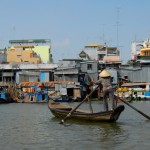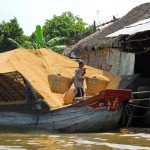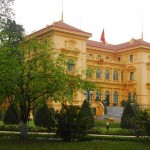Vietnam today: Ann Duncan photos
Ann Duncan | Jul 9, 2010
Our trip to Vietnam in March was interesting, ultra comfortable thanks to a private guide and driver and 5-star accommodations, and filled with color, exotic sights, sweet people, and gruesome but intriguing vestiges of the Vietnam war. (Article continues below pictures)
Vietnam in pictures! Click on thumbnail for a full-sized version.
The food was wonderfully delicious and inexpensive, and the terrain lush and beautiful, though rapidly filling up with industrial parks. This was a very civilized, mostly urban tour; overall, we preferred our leisurely, bucolic 8-day trip up the Mekong River in Cambodia to the fabulous ruins at Angkor Wat, despite constant reminders of the atrocities committed by the Khmer Rouge in the 70’s — a horrific period in their history. If we return to Vietnam, we would like to explore the highlands and meet some of the ethnic hill tribes.
Constant flow of scooters
Our number one impression of Vietnam was frenzied, cacophonous chaos. Vietnam has a population of 88 million people (8.5 million in Saigon), most of whom seem to own a motor scooter equipped with a horn. They are ubiquitous on the roads, highways and even sidewalks, weaving wildly through trucks and cars, always beeping loudly and frequently. There are few traffic lights to control the constant flow of scooters moving in every direction at once, and lanes seem to mean nothing, but miraculously there are few accidents among the tangle of vehicles. Duncan likens the scene to one of those action-filled video games. The loads on the scooters are amazing: up to four people, refrigerators, TV’s, windows, doors, mirrors, beds, construction materials, pigs going to market, dogs going to market, roosters going to cock fights. Crossing the street in this heavy traffic seemed almost impossible at first, but we learned to just walk right out into the sea of beeping scooters, maintaining a steady pace, and they just went around us as if we were rocks protruding from a river. Somehow, we always made it to the other side without being flattened. People and bags of rice were as plentiful as the scooters.
Vietnam has been experiencing a huge economic boom during the past 15-20 years. It’s a Communist country, but the doors were opened to free trade in 1986, and the development hasn’t stopped since; there are signs of capitalism and materialism everywhere. Massive construction projects dot the terrain between rice fields near the cities: highways, bridges, industrial parks, hotels, and giant ugly apartment complexes for the burgeoning population. The imperial palaces, tombs and Buddhist pagodas we visited provided a welcome quiet respite from the noise and chaos outside. Amid all the piled-on local architecture, there are many signs of the French colonial occupation, notably lovely, elegant official buildings, cathedrals, and a few private residences.
Reminders of “American War”
Touring various sites and museums relating to the Vietnam war (known as “The American War” there) was depressing but educational and fascinating. It was all rather propagandist, but it was interesting to see the war from a different perspective, and we did not encounter any anti-American sentiment. We checked out the Viet Cong’s amazing tunnel complex in Cu Chi, the Reunification Palace (formerly the South Vietnam Presidential Palace), the War Remnants Museum filled with photos of the war, China Beach, Ho Chi Minh’s body laying in state in a huge Soviet-built mausoleum (we think he’s made of wax), and the “Hanoi Hilton,” but didn’t check into the latter. There were many tourists in the country, mostly Aussies, Europeans, Koreans, Chinese & Japanese, but remarkably few Americans. We think maybe the war is just too fresh in people’s minds.
Despite the unmitigated growth near the cities, there are still many signs of Third World culture, especially in the country and open markets, where every kind of food imaginable is traded daily, including various types of fish, eels & frogs, plus the popular designer knockoffs (Izod, Polo, RayBan). Farmers plow their fields with water buffalo, street vendors carry their produce in bamboo baskets suspended from the ends of a long pole, and many people still wear the traditional conical hat, especially in the countryside and on the rivers. The bustling floating markets on the Mekong River were one of the most fascinating and photogenic sights.
Observations & trivia:
1) The French gave the Vietnamese delicious French bread; the Americans gave them flush toilets.
2) One of the Nguyen dynasty emperors had his 103 concubines collect dew from lotus flower leaves every morning for his tea.
3) At all public sites, museums, toll roads, ferries etc., there are two officials in uniform: one whom you pay for a ticket, the other who takes your ticket. This helps to keep everyone employed.
4) Thanks to widespread corruption, the police are the wealthiest people in Vietnam. Bribes are always accepted readily, especially for traffic offenses.
5) Despite the Communist regime, education and medical care are not provided by the government. Children go to school 6 days a week, usually for only 4 hours, as there are so many children and not enough schools to house them all at one time.
6) The minimum wage was recently raised to approximately $40/month. Life is quite difficult for most Vietnamese, and they are always working.
I will send a report on Cambodia soon.
















